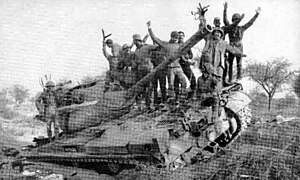Battle of Basantar
| Battle of Basantar/Shakargarh | |||||||
|---|---|---|---|---|---|---|---|
| Part of the Indo-Pakistani War of 1971 | |||||||
 Indian Army personnel celebrate Indian victory at the end Battle of Basantar on top of a knocked out Pakistani Patton tank. |
|||||||
|
|||||||
| Belligerents | |||||||
|
|
|
||||||
| Commanders and leaders | |||||||
|
|
|
||||||
| Strength | |||||||
| 3 infantry divisions 2 armoured brigades |
3 infantry divisions 1 armoured division 1 armoured brigade |
||||||
| Casualties and losses | |||||||
| 10 tanks destroyed | 46 tanks destroyed | ||||||
The Battle of Basantar or the Battle of Barapind (December 4–16, 1971) was one of the vital battles fought as part of the Indo-Pakistani War of 1971 in the western sector of India. The Indian troops won a hard fought battle that secured this area in the Punjab/Jammu sector. The name Battle of Basantar actually encompasses the entire gamut of battles and skirmishes fought in the Shakargarh sector.
Basantar river is a tributary of the Ravi River that flows in the states of Punjab and Himachal Pradesh. This battle took place in the Shakargarh Sector or the Shakargarh Bulge that includes Jarpal and surrounding areas. The bulge is a protrusion of Pakistan boundary into Indian territory. It was a strategic area for both sides as it comprised road links to Jammu from Punjab, which could be cut off by Pakistan if it wished to launch an offensive. It was also economically vital for both sides as it straddled the fertile area of the Indus river belt.
As the war began on the eastern front, Pakistan decided to open up the western sector to divert Indian troops from the Eastern front in Bangladesh and prolong the war. Shakargarh bulge was a key strategic area for India as it comprised road links between Jammu and Indian Punjab. Therefore, securing the region was crucial for India as Pakistan had a military base nearby in Sialkot and therefore could have easily launched a massive invasion of the Shakargarh region, cutting Jammu and Kashmir from the rest of India. The Indian Army maintained a base at Pathankot, couple of hundred miles away from Shakargarh and quickly mobilized forces to defend the region. In an attempt to gain advantage through the element of surprise, the Indian Army, though outnumbered, attacked Pakistani positions in Jarpal area, triggering the Battle of Basantar.
Both the opposing sides were led by their army's I Corps. Pakistan's I Corp included three infantry divisions, one armoured division, an armoured brigade backed up by an unknown number of artillery and support units. Furthermore, Pakistan had the advantage of bringing in the reserve troops stationed nearby. The Reserves totaled 5 divisions, commanded by none other than Lt. General Irshad Hassan Khan, who as DMI (Director Military Intelligence) had failed to act in the 1965 War in spite of intercepting Indian war plans. The Indian I Corps had three infantry divisions, 2 Armoured Brigades, two independent artillery brigades and an engineer brigade. The aim of the Indian Army was to bridge the Basantar river — the entry to which was fully land mined — and take control of the Shakargarh bulge. It was reasoned that such an offensive would also secure the Pathankot army base from any attacks from Pakistan.
...
Wikipedia
